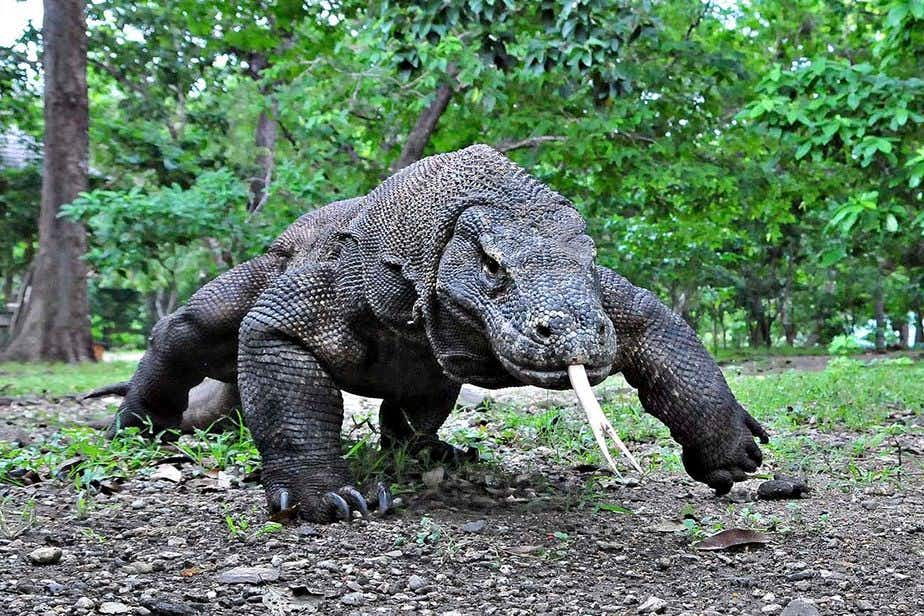Login
No account yet?
Create Account
Komodo Dragon
Largest lizard in the world. And lethal ...
0 travellers have this on their Bucket List
0 been here
The Komodo dragon is immense and a living reminder of the time of the dinosaurs. They can grow up to two meters and are not afraid of anything. These mighty animals only live in a small part of the world. These dragons, as they are often called, only live on the Komodo Islands. You can visit the island and watch these wonderful creatures, from a distance.
This omnivore is dangerous even for humans. The two strong weapons. To catch live animals, it only needs to bite its prey briefly. Its poison does the rest, the prey dies shortly afterwards. After which all he has to do is smell the nearly carcass of an animal.
The animals have been lucky that their skin is unsuitable for making bags or shoes. Scientists think they would otherwise have been extirpated long ago. Despite this, their numbers declined rapidly over the past century. Partly for this reason, the large islands of Komodo, Rinca and Padar in Indonesia have been protected since 1980.
Extinction on the island of Padar
Despite the declaration of Komodo National Park, the animals are not yet fully protected. For example, the Komodo dragon recently became extinct on the adjacent island of Padar. According to scientists, this has various causes, which indirectly have major consequences for the animals.
Illegal farming and forest clearing displace the animals, while illegal deer poaching left the monitor lizards to starve. These animals are one of the main prey of the reptiles. Feral dogs are also a problem. They also hunt scarce game, but they also like the eggs of the monitor lizard.
Flores
Incidentally, on the island of Flores, outside the national park, there are also a few dozen Komodo dragons. Even today, the animals on the island of Flores are virtually outlaws. This area does not belong to the national park and the clearing of forest and poaching have already ensured that these animals do no longer occur in an area of 150 kilometers.
The government has forced the villagers on the various islands to exchange their agricultural land for fishing. Which brings new problems to the surface. For example, fishing with dynamite and cyanide is common, with devastating effects on fish stocks and coral.
In addition, in some places overfishing occurs, while massive coral is being destroyed for the capture of shellfish. Park rangers from Komodo NP therefore have the task not only to surveillance on land, but also at sea. The area of this park is immense, so it is not easy to maintain the rules.
Feeding Komodo dragons
To give tourists the guarantee that they would see Komodo dragons, the animals were fed for a long time. This was mainly done with dead goats, which resulted in spectacular images. But the animals lost their hunting habits, eventually causing some to starve to death, after a while less tourists arrived. Since 1998, feeding has been banned by the government.
Bacteria versus poison
Scientists have long believed that Komodo dragons had bacteria in their mouths that are deadly to many animals, as well as humans. Research in May 2009 provides a newer vision. A Komodo dragon bite is deadly due to venom glands in the animal's mouth.
Australian scientist Bryan Fry has discovered this. According to him, the animals have real venom glands, just like various snake species. The poison produced by those glands first puts a monitor's prey into shock. It also leads to the victim's blood flowing faster and no longer clotting.
Human victims
The Komodo dragon poison is also deadly to humans. There are no exact figures, but some deaths are known. In March 2009 a fisherman died on the way to the hospital. In 2006, in Kampung Komodo, the only village on the island of Komodo, an 8-year-old boy was suddenly bitten by a Komodo dragon. He died before the residents could give him antiserum. Since then, the village has a fence to keep the animals out.
What's the prey of a Komodo dragon?
Komodo dragon hunt on many animals. Some of these animals are natural prey, but there are also imported animals. For instance horses once released by the Sultan of Burma on the island of Rinca. Only a few of them are still running today. Feral cats, dogs and goats are also found on all islands. All of which are on the Komodo dragons menu. They hunt from ambush to bite them, the poison does the rest.
Best place to see a Komodo dragon
0 travellers have this on their Bucket List
0 been here


